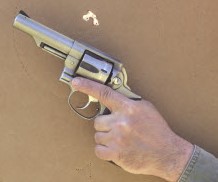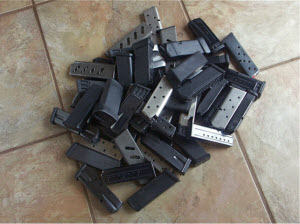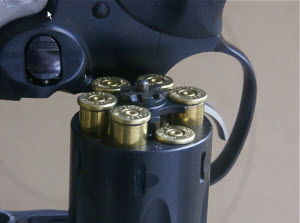
HOW I LEARNED TO LOVE THE WHEELGUN
I’m sure you’ve heard it before: someone asks, “Which is better: revolver or autoloader?” Everyone chimes in that revolvers are more reliable and simpler to operate. Over and over again. Yadda yadda yadda.
Related PDN Video: Getting Started Shooting a Revolver
Those things are generally true, but there are some less obvious and perhaps even more compelling advantages to selecting a revolver as your concealed handgun for personal defense. They include:
- Malfunctions: almost non-existent
- Practice: operates without ammunition, making dry fire useful
- Concealed carry: easier to conceal and more stable to carry on your body
- Economical: lower initial cost plus no cost for magazines
- Tactical: resistant to induced failures
Intrigued? Read on for the details of these factors that you may not have considered, and perhaps not even known, about “those old-fashioned things at the back of the showcase.”
MALFUNCTIONS
Let’s start with the learning curve. Yes, a revolver is simple to operate, in the sense that there are no controls that must be manipulated in order to fire it. What’s not obvious is the advantage in training to operate the gun to its maximum efficiency.
If you’re shooting an autoloader, it’s in your best interest to practice malfunction drills on a regular basis. Learning to identify and clear the most common jams takes time, both in initial training and regular practice. That’s time you’re not spending learning to actually deal with the dynamics of a critical incident, which is what’s going to keep you safe.
Training in malfunction clearing with a self defense revolver is nearly non-existent. There’s really only one common jam that will tie up a revolver, the dreaded case under extractor, and it is completely preventable by learning proper reloading technique, which you need to learn anyhow. Any of the uncommon malfunctions can be prevented through normal maintenance and using quality ammunition.
The failure to fire remedy? Pull the trigger again. No need to spend valuable training time (and money) learning some tap-rack-bang-do-the-hokey-pokey routine just to keep your gun running. That means less time monkeying with the gun and more time shooting.
Speaking of training, one of the overlooked features of the revolver is that it operates without ammunition. This means that dry firing is actually useful! Instead of interrupting your train of thought to rack a slide and reset a hammer, you can concentrate on performing a complete trigger sequence. Because the brain is able to perceive a complete cycle of events, a short dry-fire session is all that’s needed to implant proper trigger control technique in the mind.
Concealed Carry
Many people will tell you that a self defense revolver is hard to carry concealed. The cylinder, they say, is darn near impossible to hide. I’ve found that it’s just the opposite: the revolver is actually easier to conceal, despite the cylinder!
With an auto, the part that sticks out is the squared-off butt of the frame. No matter how thin the gun is, you still have that bottom corner poking through your cover garment. It’s hard to hide because it’s not organic; we don’t normally see right angles protruding from beneath clothing.
The grip of the revolver, on the other hand, is rounded. It doesn’t protrude as far because it’s typically shorter, and the smooth profile doesn’t catch clothing and scream “GUN!” The cylinder, likewise, is a round shape that easily disappears under clothing.
If you have kids, try this experiment: put on a dress shirt and grab some of your children’s Legos. Stand in front of a mirror and put a couple of Legos in your shirt pocket. Notice how the square edges stand out? Now go get a couple of marbles (or perhaps some jelly beans) and replace the Legos with them. Notice how those round shapes are less obvious, and even harder to identify? Same principle.
 If you keep the gun on a nightstand, in a drawer, on the floor under your bed, or on any flat surface, you’ll find the revolver is easier to pick up. The cylinder holds the grip up and away from the supporting surface, making your grasp faster and less fumble-prone.
If you keep the gun on a nightstand, in a drawer, on the floor under your bed, or on any flat surface, you’ll find the revolver is easier to pick up. The cylinder holds the grip up and away from the supporting surface, making your grasp faster and less fumble-prone.
The same is true for a revolver carried on your person. The cylinder provides a slight amount of clearance from the body, making it easier to get a good combat grip. Again, less fumbling and surer draws are the results.
Since the grip isn’t filled with heavy ammunition, it won’t be constantly trying to move in gravity’s direction. Revolvers carried in concealment tend not to shift around as much as autos, keeping their grips in the same place all the time. When you are faced with employing your gun during an emergency, that kind of consistency is important.
Money Talks
Revolvers are economically more efficient, too. I’m not talking about initial cost, though a revolver does tend to be less expensive than an auto of equal quality. It’s all the other stuff that comes into play.
 First, you don’t have the expense of magazines. If you’re serious about your defensive hardware, you should have five or six magazines on hand to fit any autoloader. Magazines do wear, they can be damaged (especially if you practice realistically), and therefore they need to be replaced occasionally. At today’s prices, that can add a couple hundred dollars to the initial cost of the gun, not to mention the cost of replacement. These are expenses that a revolver just doesn’t have.
First, you don’t have the expense of magazines. If you’re serious about your defensive hardware, you should have five or six magazines on hand to fit any autoloader. Magazines do wear, they can be damaged (especially if you practice realistically), and therefore they need to be replaced occasionally. At today’s prices, that can add a couple hundred dollars to the initial cost of the gun, not to mention the cost of replacement. These are expenses that a revolver just doesn’t have.
Most authorities recommend extensively testing an autoloader with the quality defensive ammunition you intend to carry. While specifics vary, a commonly cited figure is 200 rounds to verify function and reliability. With ammo prices what they are, you could nearly buy a new gun with that money!
With a revolver, you’re primarily testing for point of aim—to adjust the sights or to verify that the bullet impact matches non-adjustable sights. A couple of cylinders will do it, and you can go back to shooting cheaper practice ammo. That’s a huge savings!
Tactical Advantages
During an actual encounter, you’ll find that the revolver has some definite tactical advantages as well. A revolver isn’t dependent on having just the right grip in order to run, and “limp wristing” malfunctions simply don’t exist. This means that shooting from awkward positions or while injured won’t result in a jammed gun, as can happen with an autoloader. Strong side or weak side, pulling the trigger will fire the revolver every time.
In close-quarters fights, the revolver is more resistant to induced failures. While both autos and revolvers can be deliberately rendered inoperable by a very determined assailant, the revolver won’t be sidelined by inadvertent occurrences: clothing that fouls the slide, ejected casings that get knocked back into the ejection port, or slight contact that slows the slide enough to induce a malfunction. The shrouded or concealed hammer revolvers in particular are about as immune to induced malfunctions as can be imagined.
Resting My Case
When all is said and done, the revolver remains the quintessential personal defensive tool. It’s best in one-on-one fights in close quarters, where its strength as a reactive device can best be utilized. I’d never suggest that it’s the right tool for a SWAT callout serving a warrant on a drug house, or a SEAL team taking out a hive of Tangos. Those are proactive fights that call on the strengths of the autoloading sidearm.
 But you and I live in a different world. While it’s fun to play Walter Mitty and imagine ourselves defeating an entire street gang singlehandedly, the reality is that one-on-one violent crime is still the most common type encountered by legally armed citizens. In that reality, the revolver’s unappreciated advantages make it a viable choice for self-defense
But you and I live in a different world. While it’s fun to play Walter Mitty and imagine ourselves defeating an entire street gang singlehandedly, the reality is that one-on-one violent crime is still the most common type encountered by legally armed citizens. In that reality, the revolver’s unappreciated advantages make it a viable choice for self-defense

Really cool write up and comments. Thanks everyone. I mean...I'm all Glock-ed up like every other Tom, Dick and Harriet, but I am definitely getting a couple of low price, high value revolvers. And let's just face it...they're a lot of fun. I'm just getting back into firearms and have shot a bunch of different types, but I always enjoyed my late dad's Ruger Blackhawk ....just target practicing out in the boonies of Western WA with my hombres. I'm not the hugest gun guy but that was really cool.
It's a nicely written argument. I see alot of point in it, but you can not shoot 1200 rounds per minute with a revolver like you can with a glock hehe.
If your moment of truth ever arrives, then you'll probably only fire 5 or fewer rounds and it will likely be within 0-15 feet range. Probably either you or your adversary is going to get mortally shot within 1 to 5 seconds and become all but completely physically incapacitated with 30 seconds before one of you die. It's probably going to happen so fast that the confrontation might be over faster than you could state your full legal name. That's what the shooting statistics indicate and that hasn't changed much since at least the early 1980's when I first became aware of them. So (IMO) capacity, sophisticated optics and bullets that could knock down a rhino aren't going to matter much at that time. But, your alertness, speed, accuracy at close range and the consistent ability to execute what you trained yourself to do - are what you're really going to be staking your life on. If you are confident that you can do that with your favorite revolver, then it's probably the right gun for you depend on. "Just saying" it might be wise to prepare and train according to what statistics indicate are most probable.
Most revolvers are more aesthetically pleasing as well, but I'm sure that opinion varies greatly among shooters. One of the things that I like the most about revolvers, is not having to search for spent brass or being hit by it!
I’m a retired LEO who, in ‘74, was involved in a gun fight with armed robbers. I had my issued Colt six shooter .38 and had to reload to stay in the fight, but ran out of ammo after firing my 12th round. The story was told by Mas Ayoob in last summers American Handgunner, Lessons from Ken Howard. Auto loaders make sense for street cops and the military, but I still carry a revolver in retirement.
Its the same tired old arguments where an author spins the disadvantages of the revolver as an advantage. Simply unconvincing. The CENTRAL ISSUE is that because the pistol chambers a round from within the handgrip, it will always have a longer barrel length for any given length of the entire firearm compared to a revolver. The latter's 6,7 or 8 round revolving chamber is forward of the handgrip and its barrel only begins even further forward. Put another way, for any given length constraint of a handgun, the revolver will always have a much shorter barrel than a pistol, which means that muzzle velocity and accuracy of the bullet's flight path will always be inferior. That is why revolver aficionados always talk about a magnum round as compensation for this shorter barrel. But that's cheating with a larger, heavier, more expensive round compared to a 9mm for instance just to account for the barrel inferiority. Also, on every gun forum, it's almost as if nobody understands physics anymore. 0.5 x mv2 (or half x mass x velocity squared). The muzzle velocity of a 9mm or 57 small calibre bullet with higher velocity and therefore kinetic energy is far more dangerous than people think. Somehow you see how authors like these spin all the disadvantages of the revolver like they don't exist. Easier to conceal? A pistol with the same barrel length as a comparable revolver will be far less bulky and shorter. There is no bulky revolver chamber bulging out too as a pistol is flattish. Its all just ingenous spin doctoring by the author. Stemming from the same CENTRAL ISSUE, the revolver is always extremely front heavy, as the chamber and the barrel is so far forward from the hand/handgrip. This introduces sight picture wavering when the arms tire. Much more than a pistol where the centre of gravity is basically at the handgrip. An analogy is like holding a hammer vertically versus horizontally with the hammerhead at the extreme furthest end away from the hand. Which would you prefer? Somehow the author then proceeds to spin this front heavy characteristic as an advantage. I will point out, at this point, this fallacy again about how some ignorant types seem to think that firearms should be front heavy to combat muzzle rise. There is no such thing as muzzle rise as there is no vertical upward force acting on the muzzle on firing. Any rising of the muzzle is due to the rotation (RE: moment/couple) due to the barrel being higher than the point of support of the hand. This is the reason why Eugene Stoner introduced the M16 with a straight in-line barrel to butt stock design. All revolvers, due to the size of the chamber and the barrel being in front of and much higher above the handgrip, will therefore introduce far more rotation on firing. This is the reason why revolvers almost always produce far more felt recoil and "muzzle rise". This is the reason why Glocks and other modern semi-auto pistols are able to bring their barrels much lower and closer to the handgrip. This reduces the moment/couple forces and reduces the "muzzle rise" issue significantly. This means far greater accuracy and speed in target re-acquisition in rapid shooting or double-tapping/triple-tapping. In truth, accuracy is not about having smaller bullet groupings. Its about how usable a firearm is. Based on the above, pistols are far more usable and easier to fire repeatedly due to the lower felt recoil. There is no basis to support the fact that revolvers can be more accurate. Comparing all modern pistols with any revolver, the scientific/engineering fact is that there are far fewer moving parts in the pistol where the pistol and the firing chamber is one and the same. However, a revolver has a variance between 6 to 8 or even 9 chamber alignments with the barrel. Not to mention the gap between the revolving chamber and the barrel. Over time, such variances will increase with time, wear and tear from firing. Nobody questions the inconvenient fact about how sand/mud can get into the revolving chamber and cause problems too. How conveniently inconvenient? Only the issue about magazine costs are truly objective, unbiased and valid. But conversely the bullet capacity and reloading speed is also far in favour of the pistol as a result. For balance, I would also add that there is no magazine spring fatigue issue with keeping a revolver fully loaded indefinitely.
I’ve been absent for some time, but now I remember why I used to love this site. Thank you, I’ll try and check back more frequently. How frequently you update your website?
Niiiiice. The revolver is no longer an evolver. It's evolved to the point where there is very little room for improvement. Yay revolvers!
Funny you should say that you would never suggest revolvers for SWAT or SEAL, scince many entry teams and SWAT use R8 and TRR8 revolvers.
This is obviously for fans of the revolver, I really get tired of the "if lightning strikes theory", first off who's ever been in a shoot out? And out of that one in a million that have, has their gun malfunctioned in that moment? yeah if you have a club thumb and someone breaks in your home and your gun is laying on your night stand (you most likely have a mental issues or live in the worst neighborhood in America if you have a gun laying on your night stand) you might have trouble picking up an automatic. Let's try and be a little more realistic with our post's.